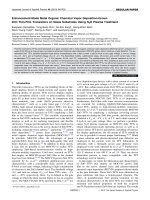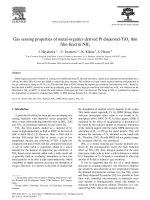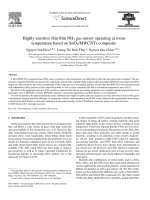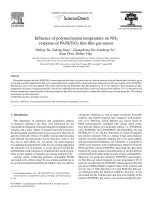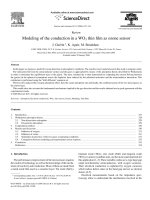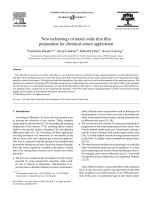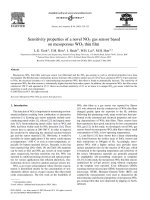- Trang chủ >>
- Khoa Học Tự Nhiên >>
- Vật lý
thin film polypyrrole swcnts nanocomposites-based nh3 sensor
Bạn đang xem bản rút gọn của tài liệu. Xem và tải ngay bản đầy đủ của tài liệu tại đây (2.9 MB, 32 trang )
Accepted Manuscript
Title: Thin Film Polypyrrole/SWCNTs
Nanocomposites-Based NH
3
Sensor Operated at Room
Temperature
Authors: Nguyen Van Hieu, Nguyen Quoc Dung, Tran Trung,
Nguyen Duc Chien
PII: S0925-4005(09)00393-1
DOI: doi:10.1016/j.snb.2009.04.061
Reference: SNB 11530
To appear in: Sensors and Actuators B
Received date: 13-1-2009
Revised date: 24-3-2009
Accepted date: 23-4-2009
Please cite this article as: N. Van Hieu, N.Q. Dung, T. Trung, N.D.
Chien, Thin Film Polypyrrole/SWCNTs Nanocomposites-Based NH
3
Sensor
Operated at Room Temperature, Sensors and Actuators B: Chemical (2008),
doi:10.1016/j.snb.2009.04.061
This is a PDF file of an unedited manuscript that has been accepted for publication.
As a service to our customers we are providing this early version of the manuscript.
The manuscript will undergo copyediting, typesetting, and review of the resulting proof
before it is published in its final form. Please note that during the production process
errors may be discovered which could affect the content, and all legal disclaimers that
apply to the journal pertain.
Page 1 of 31
Accepted Manuscript
1
Thin Film Polypyrrole/SWCNTs Nanocomposites-Based NH
3
Sensor
Operated at Room Temperature
Nguyen Van Hieu
a,
*, Nguyen Quoc Dung
a
, Tran Trung
c
, Nguyen Duc Chien
b
a)
International Training Institute for Materials Science (ITIMS), HUT
b)
Institute of Engineering Physics (IEP), Hanoi University of Technology (HUT)
c)
Faculty of Environment and Chemistry, Hung Yen University of Technology and Education, Vietnam
*Corresponding author
Nguyen Van Hieu, Ph.D.
International Training Institute for Materials Science (ITIMS),
Hanoi University of Technology (HUT)
No.1, Dai Co Viet Road, Hanoi, Vietnam
Phone:
Fax:
E-mail:
Post address:
84 4 38680787
84 4 38692963
/
No.1 Dai Co Viet, Hanoi, Vietnam
Manuscript
Page 2 of 31
Accepted Manuscript
2
Abstract - A PPY/SWCNTs nanocomposite-based sensor with relatively high sensitivity and fast 1
response-recovery was developed for detection of NH
3
gas at room temperature. The gas-sensitive 2
composite thin film was prepared using chemical polymerization and spin-coating techniques, and 3
characterized by Fourier transformed infrared spectra and Field- emission-scanning-electron 4
microscopy. The results reveal that the conjugated structure of the PPY layer was formed and the 5
functionalized SWCNTs were well-embedded. The effects of film thickness, annealing temperature, 6
and SWCNTs content on gas-sensing properties of the composite thin film were investigated to 7
optimize the gas-sensing performance. The as-prepared thin film PPY/SWCNTs composite sensor 8
with optimized process parameters had a response of 26 to 276% upon exposure to NH
3
gas 9
concentration from 10 to 800 ppm, and their response and recovery times were around 22 and 38 s,10
respectively.11
Keywords: Gas sensor; Carbon nanotubes; Polypyrrole; Nanocomposite12
13
14
Page 3 of 31
Accepted Manuscript
3
1
INTRODUCTION2
Conducting polymers such as polyaniline, polypyrrole (PPY), polythiophene, and their 3
composites have been widely investigated as effective materials for chemical sensors [1-10]. Among 4
the conducting polymers, PPY and its composites have attracted considerable attention because they 5
are easily synthesized, have relatively good environmental stability, and surface charge 6
characteristics that can be easily modified by changing the dopant species into the materials during 7
the synthesis. It has been demonstrated that there are many approaches in the enhancement of the 8
mechanical strength, chemical stability, and gas-sensing properties by combining PPY with organic 9
and inorganic materials to form composites [6]. A large number of reports have been published on 10
chemical polymerization and electrochemical techniques to prepare polypyrrole/inorganic (TiO
2
, 11
Fe
2
O
3
, SnO
2
, WO
3
…) and organic (poly[vinyl alcohol], carbon nanofibers, carbon 12
nanotubes)/polypyrrole nanocompiste sensors to detect a wide variety of gases such as NO
2
[7], 13
humidity [11-13], H
2
S [14], VOCs (volatile organic compounds) [15,16], CO
2
[17,18], and NH
3
14
[19,20].15
The special geometry of carbon nanotubes (CNTs) and their amazing feature of being 16
all-surface reacting materials offer great potential applications such as in gas sensor devices working 17
at room temperature. It has been reported that CNTs are very sensitive to the surrounding 18
environment. The presence of O
2
, NH
3
, NO
2
gases and many other molecules can either donate or 19
accept electrons resulting in an alteration of the overall conductivity [22,23]. Such properties make 20
CNTs ideal for nano-scale gas sensing materials, and CNTs FETs (Field Effect Transistors) and 21
conductive-based devices have already been demonstrated as gas sensors [24,25]. However, CNTs 22
still have certain limitations for gas sensor application such as their long recovery time, limited gas 23
detect, and weakness to humidity and other gases. Therefore, the composites of PPY and CNTs have 24
received a great deal of attention for gas-sensing application. PPY/SWCNTs and PPY/MWCNTs 25
Page 4 of 31
Accepted Manuscript
4
composites-based sensors have been already developed for the detection of ethanol and NH
3
, 1
respectively [16,26]. They have shown a higher sensitivity than both PPY- and CNTs-based sensors2
separately over a wide range of gas concentrations at room temperature. However, the sensing 3
properties of nanocomposite thin film have not yet been investigated in depth. 4
NH
3
gas presents many hazards to both humans and the environment. Due to its highly toxic 5
characteristics, even low level concentrations (ppm) pose a serious threat. NH
3
sensors based on 6
conventional materials such as SnO
2
[27,28], TiO
2
[29,30], In
2
O
3
[31,32], WO
3
[33,34] and ZnO7
[35,36] have been developed with good sensitivity and selectivity and fast response-recovery that 8
can be used in detecting lower level ammonia gas presence. However, most of the NH
3
gas sensors 9
are fabricated using metal oxides which are only effectively operated at temperature ranges between10
150-400°C, resulting in high power consumption and complexities in integration. Thus, there is a 11
great need to develop a new class of materials for gas sensors that would have good performance 12
working at room temperature. In this paper, we present the sensing-properties of the PPY/SWCNTs 13
nanocomposite thin film, prepared by simple and straightforward in situ chemical polymerization of 14
pyrrole mixed with SWCNTs, toward low concentration of NH
3
(10 - 800 ppm) at room temperature.15
The influence of film thickness, SWCNTs content, and annealing temperature are studied to 16
optimize the gas-sensing properties of the composite thin film.17
18
EXPERIMENTAL19
1. Material synthesis and characterizations20
All the chemicals used were of analytical grade. The SWCNTs were produced by CVD21
(chemical vapor deposition, Shenzhen Nanotech Port Co. Ltd. diameter <2 nm, length: 5–15 m, 22
purity: >90%), and they exist as agglomerates. Therefore, the SWCNTs were functionalized to 23
enhance their dispersion in the solvent. The functionalization was carried out using a typical 24
procedure, as follows: 200 mg SWCNTs were suspended in 35 mL concentrated nitric acid (15 M) 25
Page 5 of 31
Accepted Manuscript
5
and refluxed for 12 h in a silicone oil bath maintained at 120
o
C to modify the SWCNTs surface, 1
then rinsed with distilled H
2
O until the pH of the solution was neutral, and finally dried at 80
o
C in a 2
vacuum oven (~10
-2
torr). 3
The formation of the nanocomposite of PPY and f-SWCNTs (functionalized SWCNTs) was 4
carried out by in situ chemical polymerization of pyrrole monomer with f-SWCNTs. 3.0 ml sodium 5
dodecylbenzenesolfonate (DBSA) was dissolved in a solution of 20 ml water, then 0.1 g f-SWCNTs6
was added and stirred by ultrasonic for 30 min to obtain a well-suspended SWCNTs. The SWCNTs 7
suspension was then transferred into a flask and allowed to stand at a temperature of 0-5
o
C for 30 8
min. The pyrrole monomer (1 ml) was afterwards slowly added drop-wise to the SWCNTs 9
suspension with constant magnetic stirring for 30 min at the temperature of 0-5
o
C, then 0.345 g 10
(NH
4
)
2
S
2
O
8
(APS) was added to start the polymerization process lasting 12 h. After the 11
polymerization was finished, the composite powder formed was filtered and rinsed with DI water, 12
methanol, acetone, and ethanol until the filtrate became colorless. The as-prepared composite 13
powder was then dried in vacuum at room temperature. 14
Fourier transformed infrared (FTIR, Niconet 6700) and field-emission scanning electron 15
microscope (FE-SEM, 4800 Hitachi, Japan) were used to characterize the as-synthesized materials.16
17
2. Sensor preparation and characterizations
18
A certain amount of the nanocomposite powder was suspended into 2 ml CHCl
3
(Chloroform, 19
containing 0.5ml DBSA) by ultrasonic stirring for 30 min. The composite suspension with different 20
contents (0.005, 0.01, 0.03, 0.1 g/ml) was prepared for variation of the film thickness by 21
spin-coating at 3000 rpm. A silicon substrate with interdigitated- electrode on the top was used for 22
the gas-sensor fabrication. The interdigitated-electrode was fabricated using a conventional 23
photolithographic method with a finger width of 100 µm and a gap size of 140 µm. The fingers of 24
interdigitated-electrode were fabricated by sputtering 10 nm Ti and 200 nm Pt on a layer of silicon 25
Page 6 of 31
Accepted Manuscript
6
dioxide (SiO
2
) with the thickness of about 100 nm thermally grown on top of the silicon wafer. The 1
coating layers were dried in vacuum and then immersed in methanol to remove DBSA. Finally, the 2
samples were annealed at different temperatures (25, 200, 300, 400
o
C) for 40 min.3
The gas sensors were tested with NH
3
using the injection technique. More details about this4
testing system can be found elsewhere [37]. The electrical resistance response during testing was 5
monitored by the Precision Semiconductor Parameter Analyzer (HP4156A). The sensor response (S) 6
for a given measurement was calculated as follows: S = R
g
/R
a
, where R
g
and R
a
are electrical 7
resistances of the sensor in tested gas and in air, respectively. 8
9
RESULTS AND DISSCUSION10
1. Material characterizations11
Fig. 1 presents the FT-IR spectra of PPY and PPY/SWCNTs composite. It is clear that PPY and the 12
composite show very similar spectra. The peaks at 2917 and 2854 cm
−1
are associated with five 13
membered ring C–H stretching [21]. The stretching and bending motion of N–H in PPY appear at 14
3361 and 1645 cm
−1
, respectively [21,38]. The peaks at 1249 cm
-1
and 1086 cm
-1
are due to C-N 15
stretching and C-H deformation vibrations of PPY [21,26,40]. Additionally, the peaks at 991 and 16
853 cm
-1
related to the in-plane and out-of-plane vibration modes of N-H and C-H [38,39]. It can be 17
recognized that the PPY and SWCNT/PPY composites show nearly identical numbers and positions 18
of the main IR bands, and that the characteristic peaks of MWNTs are hardly seen. The intensity of 19
the transmission light to the SWCNTs is very low, and the corresponding reflective or scattering 20
light has to transfer the matrix layers of the conducting polymers. However, the matrix layer of the 21
PPY has absorbed much of this light, suggesting that the SWCNTs are well-embedded within the 22
matrix of the PPY [41,42].23
Fig. 2 shows the FE-SEM images of f-SWCNTs (Fig. 2a), PPY (Fig. 2b), and the 24
f-SWCNTs/PPY composite (Fig. 2c). The typical morphology of PPY indicates that the particle size 25
Page 7 of 31
Accepted Manuscript
7
of PPY is lower than 100 nm with spherical morphology. The obtained morphology of the1
f-SWCNTs shows that many nanotubes are loosely entangled without any particle-like impurities. 2
The morphology of the as-synthesized PPY/SWCNTs composite (see Fig. 3c) shows that the 3
SWCNTs are well-embedded within the matrix of the PPY. The FT-IR spectra and FE-SEM 4
characterizations confirm that the as-synthesized SWCNTs/PPY nanocomposite prepared in the 5
present work are similar to the carbon nanotubes/PPY composites prepared by previous reports such 6
as through chemical polymerization [41,42] vapor phase polymerization [26], and electrochemical 7
polymerization [43,44].8
9
2. Gas-sensing properties10
Fig. 3 shows a typical response curve of the thin film SWCNTs/PPY composite gas sensors 11
during gas-sensing at room temperature. The response curve indicates that the resistance signal 12
varies with time over the two of cyclic tests. Before each cyclic test, the sensor was exposed to the13
air and the measured resistance of the sensor was equal to R
a
. At the beginning of each cyclic test, a 14
desired NH
3
gas was injected into the chamber (4L). The measured resistance changed gradually. 15
After a certain time, the resistance changed very slowly, almost reaching a stable value, R
g
, 16
corresponding to the response of the sensor to NH
3
gas. The glass chamber was then removed from 17
the sensor to expose the sensor to the air again. The measured resistance was restored to its original 18
value, R
a
. The 90% response time for gas exposure (t
90%(air-to-gas)
) and that for recovery (t
90%(gas-to-air)
) 19
were calculated from the resistance–time data shown in Fig. 3. The t
90%(air-to-gas)
value is around 22 s, 20
while the t
90%(gas-to-air)
value is around 38 s. As can be seen, these values are lower than those of both 21
the PPY- and the CNTs-based NH
3
gas sensors reported in the literature [45,46]. The 22
response-recovery time of the SWCNTs/PPY composite is even shorter than that of the single wire 23
and tube gas sensor devices made from PPY nanowires and SWCNTs [48,49]. The 24
response-recovery time comparison data are indicated in table I. 25
Page 8 of 31
Accepted Manuscript
8
Fig. 3 shows that the resistance of the sensor increases when it is exposed to NH
3
gas 1
(electron-donor). This behavior is similar to that of the PPY- and SWCNTs-based sensors 2
[4,7,10,17,22, 24, 27, 46-49], in which both PPY and SWCNTs behave as p-type semiconductors. 3
This suggests that the PPY/SWCNTs composite also behaves as a p-type semiconductor, and is 4
consistent with the case of the PPY/MWCNTs composite sensor prepared by vapor phase 5
polymerization [26]. This also implies that the adsorption of NH
3
on the PPY/SWCNTs composite 6
results in reducing the number of holes in PPY and SWCNTs because NH
3
is an electron-donating7
gas. Similar to PPY- and SWCNTs-based sensors, the electron charge transfer is the main 8
mechanism in changing the resistance of the PPY/SWCNTs on adsorption of NH
3
gas. However, 9
upon NH
3
adsorption, electron charge transfer is likely to only occur between NH
3
and PPY because 10
the SWCNTs are well-embedded within the PPY. 11
The fast response-recovery of the PPY/SWCNTs composite sensor could be explained as 12
follows. It is well-known that the adsorption process of NH
3
gas on CNTs is attributed to 13
physisorption and chemisorption, whereas chemisorption is due to site-defect on the sidewall of 14
CNTs [50-52], and the defects of CNTs are unavoidable during the synthesis and purification15
processes. Thus, NH
3
chemically adsorbed on the CNTs are hardly removed upon air exposure, 16
resulting in slow response and recovery of CNTs-based sensors. For PPY/SWCNTs-based sensors, 17
the adsorption process of NH
3
gas can only be by physisorption due to the fact that the SWCNTs are 18
well-embedded in the PPY, and the site-defects on the sidewall of SWCNTs are functionalized with 19
the PPY during the polymerization process. It has been also found that the PPY/SWCNTs-based 20
sensor in the present work exhibits shorter response-recovery time than that of the PPY-based 21
sensors reported in previous works [45,48]. This could be attributed to the fact that our sensors are22
made of the thin-film type deposited by spin-coating of the PPY/SWCNTs composite suspension.23
Another reason could be that the composite thin film forms permanent nano-channels due to the 24
hallow-core of SWCNTs, enabling the ammonia molecules to be diffused in and out of the 25
Page 9 of 31
Accepted Manuscript
9
PPY/SWCNTs composite faster than that of the pristine PPY. This also means that the 1
PPY/SWCNTs composite is more porous than the PPY, as has been already claimed by previous 2
reports [16,26]. The thin film and the porous film could be the reasons explaining why the 3
PPY/SWCNTs composite-based sensor exhibits a higher response compared to that of PPY-based 4
sensors. Additionally, SWCNTs are known to be strong adsorbers of NH
3
gas molecules [53] which5
may help the PPY to interact more easily with them. Therefore, this could be another contribution of 6
SWCNTs in the response enhancement of the PPY/SWCNTs composite sensor.7
8
a) The effect of film thickness 9
It is well known that the thickness of the sensitive layer has a great influence on the 10
gas-sensing performance of thin film sensors, which have provided a much better platform for 11
producing high performance gas sensors. However, the influence of the film thickness of PPY as 12
well as PPY/carbon nanotubes composite on their gas-sensing performance has been lacking much 13
thus far. As such, in the present work, we try to explore the effect of the thickness of the14
composite-sensing layer on the sensitivity, to find the optimal thickness for the composite gas sensor. 15
As indicated in the previous section, different the PPY/SWCNTs composite suspensions in 16
chloroform were prepared for the gas sensor fabrication with variation in the film thickness. We 17
have not yet successfully characterized the film thickness, but we believe that the film thickness 18
decreases with the decrease of the content of the composite suspension. Fig. 4a shows the sensor 19
response of all as-fabricated sensors up to 150 ppm NH
3
at room temperature. It can be seen that the 20
sensor response increases with the decrease of PPY/SWCNTs suspension content. This can be 21
attributed to the decrease of the film thickness. Fig. 4b indicates that the electrical resistance of the 22
composite film increases with decreased content of the suspension, and is confirmed by the decrease 23
of the film thickness. The mechanism of the film thickness on the response of the PPY/SWCNTs 24
composite sensor has not been yet understood thus far. However, a plausible explanation could be 25
Page 10 of 31
Accepted Manuscript
10
suggested based on the sensing mechanism of metal oxide semiconductors as previously reported 1
[54-56]. The response of the PPY/SWCNTs composite sensor depends on the reactivity and 2
diffusion of NH
3
gas molecules inside the composite-sensing thin film. Therefore, when the 3
thickness of the film decreases, the sensor response increases due to the decrease of the diffusion 4
length of the gas molecules [56]. At room temperature, the diffusion length has significant meaning 5
for gas-sensor performance. Therefore, as indicated in Fig. 4b, the sensor response increases with 6
decreasing film thickness.7
8
b) The effect of SWCNTs content9
It has been realized that the content of carbon nanotubes strongly affects the morphology and the 10
electrical property of the PPY/CNTs thin film [16,26,41,57]. Therefore, it is predicted that the 11
sensitivity of the composites sensor is influenced by varying the SWCNTs content in the composites. 12
Thus, various PPY/SWCNTs composites-based sensors, in which the SWCNTs content (weigh ratio 13
of SWCNT to PPY) was varied at 0, 0.5, 1.0, 3.0, and 5.0 wt%, were prepared and characterized. 14
Fig. 5 shows the sensing characteristics of all the as-fabricated sensors up to 150 ppm NH
3
at room 15
temperature. It is clearly seen that the response to the NH
3
gas of the PPY/SWCNTs composite gas 16
sensor increases at first as the SWCNTs content is increased up to 1 wt% but it decreases when the 17
SWCNTs content is further increased up to 5 wt%. Apparently, the composite sensor with the18
SWCNTs content of 1 wt% shows the highest response to NH
3
at room temperature, with the 19
response to 150 ppm NH
3
being about 2.2. This value is relatively higher than that of 20
PPY/MWCNTs composite NH
3
gas sensor prepared by vapor phase polymerization [16]. As 21
mentioned above, SWCNTs were covered by PPY in the composite film, and the increase of 22
SWCNTs content can result in the increase of the surface area of the PPY/SWCNTs composite, 23
providing more active sites for adsorption of NH
3
gas, and thus an increase in the sensitivity is 24
expected. However, it is well-known that the SWCNTs are composed of metallic and 25
Page 11 of 31
Accepted Manuscript
11
semiconducting CNTs, and the increase of the SWCNTs content makes the composite electrically 1
shorted, thus increasing the percolation effect by the metallic carbon nanotubes [58]; furthermore,2
the conductivity of the composite is then dominated by the metallic CNTs. This suggests that both 3
these effects could be responsible for the decrease of the composite sensor response.4
5
c) The effect of annealing temperature6
It has been reported that the heat-treatment process of the PPY/CNTs composite strongly 7
affects the electrical and gas-sensing properties of the composite sensing film because the active 8
sites of the PPY on the SWCNTs are quenched by the heat-treatment [16]. 9
Therefore, annealing temperature needs to be optimized to obtain the best performance of a gas-10
sensing device. We fabricated four PPY/SWCNTs composite sensors at the same time, and carried 11
out the heat treatment at temperatures of 200, 300 and 400
o
C for three sensors, and the last was 12
maintained at room temperature. Fig.6a shows the response of the four sensors to 150 ppm NH
3
gas 13
at room temperature. From Fig. 6b, it can be seen that the optimal annealing temperature is 300
o
C. 14
The sensor response increases with an increase of the annealing temperature from room temperature 15
(25
o
C) up to 300
o
C. This suggests that the composite is still contaminates with the solvent after 16
drying by the vacuum. The solvent is supposed to be evaporated with the increase in the annealing17
temperature, and the composite material becomes more porous. However, with further increase of 18
the annealing temperature, the number of the active sites of PPY would decrease, resulting in the 19
decreases of the composite sensor response.20
21
d) The effect of operating temperature22
Although the aim of this work was to develope room temperature gas sensors for NH
3
detection, 23
we also tested the composite sensor to 150 ppm NH
3
at different temperatures such as 25 , 40, 50
o
C 24
to examine the effect of operating temperature on the sensitivity to NH
3
gas and to find optimized 25
Page 12 of 31
Accepted Manuscript
12
operating temperature. The obtained responses of the composite sensor are shown in Figure 7. It 1
turns out that the sensor response significantly decreases with the increase in the operating 2
temperatures (see Fig. 7b). We have also tested the composite sensor at temperature of 100
o
C, and 3
found that the sensor does not respond to NH
3
gas (not show). Our sensor samples can be compared4
to the PPY-based sensors in the detection of ethanol and CO
2
gases that have been previously 5
reported [5,8], indicating that not only the PPY materials but also the composites using PPY6
materials show the highest sensitivity at room temperature. This emphesizes the advantage of the 7
sensors based on conducting polymer over the metal oxide sensors [1]. There have been several 8
works studying the mechanism of the interaction between NH
3
and PPY materials [3,8,21,26,48]. 9
However, the effect of the ambient temperature on the interaction has been not clear thus far. It has 10
been demonstrated that the humidity as well as ambient temperatures strongly affects the sensing 11
properties of PPY-based sensors. The effect of humidity on the sensing properties of PPY sensors12
has already been explained in previous works. The PPY sensor was obviously shown to have better 13
sensitivity under dry conditions than under humid conditions, and the response decreased with the 14
increase of humidity [3,8]. The reason is that the water vapor was adsorbed faster than NH
3
, and the 15
more water vapor was adsorbed, the less NH
3
was adsorbed on the surface of the PPY sensor at 16
room temperature. The effect of the ambient temperature on the sensing properties can be explained 17
as follows. As discussed above, the sensing process of the SWCNTs/PPY composite involves two 18
steps: (i) diffusion of gas molecules in the sensing-film, and (ii) the reaction between them. 19
Temperature can influence both of the two steps. An increasing temperature will shift the 20
equilibrium to desorption because adsorption always prefers low temperatures. Additionally, both 21
SWCNTs and PPY are sensing-materials with adsorption/desorption as their preponderant step 22
[1,2,22-24]. Therefore, the sensitivity of the SWCNTs composite will decrease with increased23
operating temperature. Nonetheless, we believe that the ambient temperature and humidity 24
associatively affect the sensitivity of the SWCNTs/PPY composite-based sensors.25
Page 13 of 31
Accepted Manuscript
13
1
d) The influence of NH
3
gas concentration2
The PPY/SWCNTs sensor performed at room temperature was subjected to successive 3
injections of NH
3
gas. A step-wise increase in electrical resistance obtained with increasing NH
3
gas 4
concentration from zero to 800 ppm NH
3
in the air for the PPY/SWCNTs composite sensor at room 5
temperature can be see in Fig. 8a. The response (R
g
/R
a
) of the sensor was calculated from Fig. 8a, 6
and was plotted as a function of NH
3
concentration as shown in Fig. 8b. It was found that the 7
response increases from 26 to 276% by varying NH
3
gas concentration from 10 to 800 ppm. It 8
seems that our PPY/SWCNTs composite-based sensors show a higher response to NH
3
at room 9
temperature in comparison to that of PPY-, PPY nanowires-, PPY/MWCNTs-based sensors as 10
reported previously [9,19,45,48]. It should be noted that a relatively good linear relation between the 11
response and NH
3
gas concentration is observed separately in low (10 -140 ppm) and high (140-800 12
ppm) concentration ranges of NH
3
gas. Furthermore, the response of the PPY/SWCNTs-based 13
sensor saturates as much higher NH
3
gas concentration (>600 ppm) than that of PPY-based sensors 14
[45]. This observation is consistent with PPY/MWCNTs composite-based sensor as previously 15
reported [9], suggesting that the PPY/carbon nanotubes composite sensing materials provide more 16
active sites than that of PPY material. 17
18
CONCLUSION19
The thin film PPY/SWCNTs composite-based sensor has been successfully prepared using the 20
simple and straightforward in situ chemical polymerization of pyrrole mixed with SWCNTs and 21
spin-coating method. The composite sensors have shown excellent sensitivity to NH
3
gas at room 22
temperature and relatively fast response-recovery. The response of the PPY/SWCNTs composite 23
thin film gas sensor strongly depends on the preparation process of the sensitive film, including film 24
thickness, SWCNTs content and annealing temperature. This result also implies that these 25
Page 14 of 31
Accepted Manuscript
14
conditions need to be optimized for practical applications of the composites of PPY/carbon 1
nanotubes as the gas sensors, in general. The observations of the film morphology revealed that the 2
SWCNTs are embedded in the PPY materials during the polymerization process. According to this 3
result, the sensing mechanism of PPY/SWCNTs to NH
3
gas has been discussed.4
5
Acknowledgments6
The work has been supported by the National Foundation for Science & Technology 7
Development (NAFOSTED) of Vietnam (for Basic Research Project: 2009-2011) and the National 8
Key Research Program for Materials Technology (Project No. KC 02-05/06-10).9
10
References11
1. U. Lange, N.V. Roznyatovskaya1, V.M. Mirsky, Conducting polymers in chemical sensors and 12
arrays, Analytica Chimica Acta 614 (2008) 1-26.13
2. H. Bai, G. Shi, Gas sensors based on conducting polymers, Sensors (Rev.) (7) (2007) 267-307.14
3. A.C. Partridge, M.L. Jansen, W.M. Arnold, Conducting polymer-based sensors, Mater. Sci. Eng. 15
C 12 (2000) 37-42.16
4. J.E.G. de Souza, F.L. dos Santos, B. Barros-Neto, C.G. dos Santos, C.P. De, Polypyrrole thin 17
films gas sensors, Synth. Metal 119 (2001) 383-384.18
5. S.A. Waghuley, S.M. Yenorkar, S.S. Yawale, S.P. Yawale, Application of chemically 19
synthesized conducting polymer-polypyrrole as a carbon dioxide gas sensor, Sens. Actuators B 20
128 (2008) 366-373.21
6. R. Gangopadhyay, A. De, Conducting polymer composites: novel materials for gas sensing, 22
Sens. Actuators B, 77 (2001) 326-329. 23
7. M.K. Ram, O. Yavuz, M. Aldissi, NO
2
gas sensing based on ordered ultrathin films of 24
conducting polymer and its nanocomposite, Synth. Metals, 151 (2005) 77-84.25
Page 15 of 31
Accepted Manuscript
15
8. J H. Cho, J B Yu, J S. Kim, S O. Sohn, D D. Lee, J S. Huh, Sensing behaviors of 1
polypyrrole sensor under humidity condition, Sens. Actuators B 108 (2005) 389-392.2
9. M.F. Mabrook, C. Pearson, M.C. Petty, Inkjet-printed polypyrrole thin films for vapour sensing, 3
Sens. Actuators B, 115 (2006) 547-551.4
10. M.K. Ram, Ö. Yavuz, V. Lahsangah, M. Aldissi, CO gas sensing from ultrathin nano-composite 5
conducting polymer film, Sens. Actuators B 106 (2005) 750-757. 6
11. K. Suri, S. Annapoorni, A.K. Sarkar, R.P. Tandon, Gas and humidity sensors based on iron 7
oxide-polypyrrole nanocomposites, Sens. Actuators B 81 (2002) 277-282. 8
12. R.P. Tandon, M.R. Tripathy, A.K. Arora, Surat Hotchandani, Gas and humidity response of 9
iron oxide-Polypyrrole nanocomposites, Sens. Actuators B, 114 (2006) 768-773.10
13. V. Vrkoslav, I. Jelinek, G. Broncova, V. Kra, J. Dian, Polypyrrole-functionalized porous silicon 11
for gas sensing applications, Mater. Sci. Eng. C 26 (2006) 1072-1076.12
14. L. Geng, X. Huang, Y. Zhao, P. Li, S. Wang, S. Zhang, S. Wu, H
2
S sensitivity study of 13
polypyrrole/WO
3
materials, Solid-State Electronics 50 (2006) 723-726.14
15. T. Itoh, J. Wang, I. Matsubara, W. Shin, N. Izu, M. Nishibori, N. Murayama, VOCs sensing 15
properties of layered organic–inorganic hybrid thin films: MoO
3
with various interlayer organic 16
components, Mater. Lett. 62 (2008) 3021-3023. 17
16. K.H. An, S.Y. Jeong, H.R. Hwang, and Y.H. Lee, Enhanced sensitivity of a gas sensor 18
incorporating single-walled carbon nanotubes-polypyrrole nanocomposites, Adv. Mater. (2004) 19
1005-1009.20
17. S.A. Waghuley, S.M. Yenorkar, S.S. Yawale, S.P. Yawale, Application of chemically 21
synthesized conducting polymer-polypyrrole as a carbon dioxide gas sensor, Sens. Actuators B 22
28 (2008) 366-373.23
18. S. Radhakrishnan, S. Paul, Conducting polypyrrole modified with ferrocene for applications in 24
carbon monoxide sensors, Sens. Actuators B 125 (2007) 60-65.25
Page 16 of 31
Accepted Manuscript
16
19. G. Han, G. Shi, Porous polypyrrole/polymethylmethacrylate composite film prepared by vapor 1
deposition polymerization of pyrrole and its application for ammonia detection, Thin Solid 2
Films 515 (2007) 6986-6991.3
20. N.V. Bhat, A.P. Gadre, V.A. Bambole, Investigation of electropolymerized polypyrrole 4
composite film: characterization and application to gas sensors, J. Appl. Polymer Sci. 88 (2003)5
22-29.6
21. J. Jang, J. Bae, Carbon nanofiber/polypyrrole nanocable as toxic gas sensor, Sens. Actuators B 7
122 (2007) 7-13. 8
22. H. Ulbricht, G. Moos, T. Hertel, Interaction of molecular oxygen with single-wall carbon 9
nanotube bundles and graphite, Surf. Sci. 532-535 (2003) 852-856.10
23. S. Santucci, S. Picozzi, F. Di Gregorio, and L. Lozzi, NO
2
and CO gas adsorption on CNTs: 11
Experiment and theory, J. Chem. Phys. 119 (2003) 10904-10910.12
24. A. Modi, N. Koratkar, E. Lass, B. Wei, Miniaturized gas ionization sensors using carbon 13
nanotubes, Nature 424 (2003) 171-173.14
25. J. Li, Y. Lu, Q. Ye, M. Cinke, J. Han, and M. Meyyappan, Carbon nanotube sensors for gas and 15
organic vapor detection, Nano Lett. 3 (2003) 929-933.16
26. Y S. Chen, Y. Li, H C. Wang, M J Yang, Gas sensitivity of a composite of multi-walled 17
carbon nanotubes and polypyrrole prepared by vapor phase polymerization, Carbon 45 (2007) 18
357-363.19
27. Y D. Wang, X H. Wu, Q. Su, Y F. Li, Z L.Zhou, Ammonia-sensing characteristics of Pt and 20
SiO
2
doped SnO
2
materials, Solid-State Electronics 45(2001) 347-350.21
28. V.V. Petrov, T.N. Nazarova, A.N. Korolev, N.F. Kopilova, Thin sol–gel SiO
2
–SnO
x
–AgO
y
22
films for low temperature ammonia gas sensor, Sens. Actuators B 133(2008) 291-295.23
29. I. Hayakawa, Y. Iwamoto, K. Kikuta, S. Hirano, Gas sensing properties of platinum 24
dispersed-TiO
2
thin film derived from precursor, Sens. Actuators B, 62 (2000) 55-60.25
Page 17 of 31
Accepted Manuscript
17
30. B. Karunagaran, P. Uthirakumar, S.J. Chung, S. Velumani, E K. Suh, TiO
2
thin film gas sensor 1
for monitoring ammonia, Mater. Characterization, 58 (2007) 680-684. 2
31. H. Mbarek, M. Saadoun, B. Bessais, Screen-printed tin-doped indium oxide (ITO) films for NH
3
3
gas sensing, Mater. Sci. Eng. C, 26 (2006) 500-504.4
32. V. Romanovskaya, M. Ivanovskaya, P. Bogdanov, A study of sensing properties of Pt- and 5
Au-loaded In
2
O
3
ceramics, Sens. Actuators B 56 (1999) 31-36. 6
33. X. Wang, N. Miura, N. Yamazoe, Study of WO
3
-based sensing materials for NH
3
and NO 7
detection, Sens. Actuators B 66 (2000) 74-76.8
34. V. Srivastava, K. Jain, Highly sensitive NH
3
sensor using Pt catalyzed silica coating over WO
3
9
thick films, Sens. Actuators B 133 (2008) 46-52.10
35. D.R. Patil, L.A. Patil, P.P. Patil, Cr
2
O
3
-activated ZnO thick film resistors for ammonia gas 11
sensing operable at room temperature, Sens. Actuators B 126 (2007) 368-374.12
36. M.S. Wagh, G.H. Jain, D.R. Patil, S.A. Patil, L.A. Patil, Modified zinc oxide thick film resistors 13
as NH
3
gas sensor, Sens. Actuators B 115 (2006) 128-133.14
37. N.V. Hieu, L.T.B. Thuy, N.D. Chien, Highly sensitive thin film NH
3
gas sensor operating at 15
room temperature based on SnO
2
/MWCNTs composite, Sens. Actuator B, 129 (2008) 888-895.16
38. M. Campos, F.R. Simoes, E.C. Pereira, Influence of methane in the electrical properties of 17
polypyrrole films doped with dodecylbenzene sulfonic acid, Sens. Actuators B 125 (2007) 18
158-166.19
39. Y. Shen, M. Wan, In situ doping polymerization of pyrrole with sulfonic acid as a dopant, Synth.20
Metals 96 (1998) 127-132. 21
40. G. Cho, B.M. Fung, D.T. Glatzhofer, J S. Lee, and Y G.Shul, Preparation and characterization 22
of polypyrrole-coated nanosized novel ceramics, Langmuir 17 (2001) 456-461.23
41. Y. Yu, C. Ouyang, Y. Gao, Z. Si, W. Chen, Z. Wang, G. Xue, Synthesis and characterization of 24
carbon nanotube polypyrrole core–shell nanocomposites via in-situ inverse microemulsion, J. 25
Page 18 of 31
Accepted Manuscript
18
Polym. Sci. A: Polym. Chem. 43 (2005) 6105-6115.1
42. X. Zhang, Z. Lu, M. Wen, H. Liang, J. Zhang, and Z. Liu, Single-walled carbon nanotube-based 2
coaxial nanowires: synthesis, characterization, and electrical properties, J. Phys. Chem. B 109 3
(2005) 1101-1107.4
43. X. Lin, Y. Xu, Facile synthesis and electrochemical capacitance of composites of 5
polypyrrole/multi-walled carbon nanotubes, Electrochimica Acta 53 (2008) 4990-4997.6
44. H. Arami, M. Mazloumi, R. Khalifehzadeh, S.H. Emami, S.K. Sadrnezhaad, 7
Polypyrrole/multiwall carbon nanotube nanocomposit electropolymerized on copper substrate, 8
Mater. Lett. 61 (2007) 4412-4415.9
45. H. J. Kharat, K. P. Kakde, P. A. Savale, K. Datta, P. Ghosh and M. D. Shirsat, Synthesis of 10
polypyrrole films for the development of ammonia sensor, Polym. Adv. Tech. 18 (2007) 11
397–402.12
46. E. Bekyarova, M. Davis, T. Burch, M. E. Itkis, B. Zhao, S. Sunshine, and R. C. Haddon, 13
Chemically functionalized single-walled carbon nanotubes as ammonia sensors, J. Phys. Chem. 14
B 108 (2004) 19717-19720.15
47. M. Arab, F. Berger, F. Picaud, C. Ramseyer, J. Glory, Direct growth of the multi-walled carbon 16
nanotubes as a tool to detect ammonia at room temperature, Chem. Phys. Lett. 433 (2006) 17
175-181. 18
48. S.C. Hernandez, D. Chaudhuri, W. Chen, N.V. Myung, A. Mulchandani, Single polypyrrole 19
nanowire ammonia gas sensor, Electroanalysis 19 (2007) 2125-2130.20
49. J. Kong, N.R. Franklin, C. Zhou, M.G. Chapline, S. Peng, K. Cho, H. Dai, Nanotube molecular 21
wires as chemical sensors, Science 287 (2000) 622-625.22
50. M. Grujicic, G. Cao, R. Singh, The effect of topological defects and oxygen adsorption on the 23
electronic transport properties of single-walled carbon-nanotubes, Appl. Surf. Sci. 211 (2003) 24
166–183.25
Page 19 of 31
Accepted Manuscript
19
51. S.G. Wang, Q. Zhang , D.J. Yang , P.J. Sellin , G.F. Zhong, Multi-walled carbon 1
nanotube-based gas sensors for NH
3
detection, Diam. Relat. Mater. 13 (2004) 1327–1332.2
52. J.A. Robinson, E.S. Snow, S.C. Badescu, T.L. reinecke, and F.K. Perkins, Role of defects in 3
single-walled carbon nanotube chemical sensors, Nano Lett. 6 (2006) 1747-1751.4
53. H. Chang, J.D. Lee, S.M. Lee, and Y.H. Lee, Adsorption of NH
3
and NO
2
molecules on carbon 5
nanotubes, Appl. Phys. Lett. 79 (2001) 3863- 3865.6
54. G. Sakai, N.S. Baik, N. Miura, N. Yamazoe, Gas sensing properties of tin oxide thin films 7
fabricated from hydrothermally treated nanoparticles-dependence of CO and H
2
response on film 8
thickness, Sens. Actuators B 77 (2001) 116-121.9
55. A. Zahab, L. Spina, and P. Poncharal, Water-vapor effect on the electrical conductivity of a 10
single-walled carbon nanotube mat, Phys. Rev. B 63 (2000) 1000-10002.11
56. G. Sakai, N. Matsunaga, K. Shimanoe, N. Yamazoe, Theory of gas diffusion controlled 12
sensitivity for thin film semiconductor gas sensor, Sens. Actuators B 80 (2001) 125-131.13
57. X. Zhang, J. Zhang, R. Wang, T. Zhu, and Z. Liu, Surfactant-directed polypyrrole/CNT 14
nanocables: synthesis, characterization, and enhanced electrical properties, Chem. Phys. Chem. 15
5 (2004) 998-1002.16
58. N.G. Sahoo, Y.C. Jung, H.H. So, J.W. Cho, Polypyrrole coated carbon nanotubes: Synthesis, 17
characterization, and enhanced electrical properties, Synth. Metals 157 (2007) 374-379. 18
19
Page 20 of 31
Accepted Manuscript
20
1
List of figure captions2
Fig. 1. FT-IR spectra of (a) PPY and (b) PPY/SWCNTs (1 wt. %) nanocomposite.3
Fig. 2. FE-SEM image of (a) f-SWCNTs, (b) PPY, and (c)PPY/SWCNTs composite.4
Fig. 3. Response curve of SWCNTs/PPY composite sensor to NH
3
at room temperature.5
Fig. 4. The NH
3
gas sensing characteristics of PPY/SWCNTs composite at different film 6
thickness; (a) transient responses of the sensor to 150 ppm NH
3
; (b) the sensor response as a 7
function of the film resistance. 8
Fig. 5. The NH
3
gas sensing characteristics of PPY/SWCNTs composite at different 9
SWCNTs contents; (a) transient responses of the sensor to 150 ppm NH
3
; (b) the sensor 10
response as a function of the SWCNTs content. 11
Fig. 6. The NH
3
gas sensing characteristics of PPY/SWCNTs composite annealing at 12
different temperatures; (a) transient responses of the sensors to 150 ppm NH
3
; (b) the sensor 13
response as a function of the annealing temperature. 14
Fig. 7. The NH
3
gas sensing characteristics of PPY/SWCNTs composite at different 15
operating temperature;(a) transient responses of the sensors to 150 ppm NH
3
;(b) the sensor 16
response as a function of operating temperature. 17
Fig. 8. Step wise increase in electrical resistance obtained with increasing NH
3
gas 18
concentration from air to 800 ppm NH
3
in air (a); the sensor response as a function of the 19
NH
3
gas concentration (b). 20
Table I: Response-recovery times from this work and the literatures21
22
Page 21 of 31
Accepted Manuscript
21
1
Biographies2
Nguyen Van Hieu received his MSc degree from the International Training Institute for Material 3
Science (ITIMS), Hanoi University of Technology (HUT) in 1997 and PhD degree from the 4
Department of Electrical Engineering, University of Twente, Netherlands in 2004. Since 2004, he 5
has been a research lecturer at the ITIMS. In 2007, he worked as a post-doctoral fellow, Korea 6
University. His current research interests include nanomaterials nanofabrications, characterizations 7
and applications to electronic devices, gas sensors and biosensors. Contact or 8
10
Nguyen Quoc Dung received the BS degree in Chemistry at Hanoi University of Education in 2004, 11
and MSc degree in materials science from the International Training Institute of Material Science 12
(ITIMS), Hanoi University of Technology (HUT), in 2006. Her research interest is the development 13
of conducting polymer and conducting polymer/carbon nanotubes composites gas sensing 14
applications.15
16
Tran Trung received MSc degree in 1994 and PhD degree in 1998 from Department of 17
Electrochemistry, Hanoi University of Technology. During 2000 and 2001 he worked as a 18
post-doctoral fellow in Pusan National University, Korea. At present he has been working as 19
Associate Professor at Faculty of Environment and Chemistry, Hung-Yen University of Technology 20
and Education. His research activities are related with the design, fabrication and characterization of 21
organic-inorganic hybrids and nanomaterials for application to electronic devices and battery 22
systems.23
24
25
Page 22 of 31
Accepted Manuscript
22
Nguyen Duc Chien received the engineering degree in electronic engineering at Leningrad 1
Electrotechnical University, Russian, in 1976, and the MSc and PhD in microelectronics at 2
Grenoble Polytechnique University, France, in 1985 and 1988, respectively. He has worked as 3
associated professor at the Institute of Engineering Physics (IEP), Hanoi University of Technology 4
(HUT). From 1989 to 1990 he worked as a visiting professor at the Grenoble University, France. 5
From 1992 to 2006 he was a vice director of the International Training Institute for Materials 6
Science (ITIMS), HUT, where he established a Laboratory of Microelectronics and Sensors. Since 7
2003 he has been the Director of the IEP, HUT. His research interests include: characterizations and 8
modeling of MOS devices, nanomaterials for chemical sensor, biosensor, optoelectronic materials 9
and devices, and MEMS devices. He has been a leader of many national research projects related to 10
microelectronic devices and functional nanomaterials. Dr Nguyen Duc Chien is a member of 11
Physics Society of Vietnam and Vietnamese Materials Research Society.12
Page 23 of 31
Accepted Manuscript
Figure 1
(a)
(b)
Figure(s)
Page 24 of 31
Accepted Manuscript
Figure 2
80 nm
(a)
(b)
200 nm
60 nm
(c)
